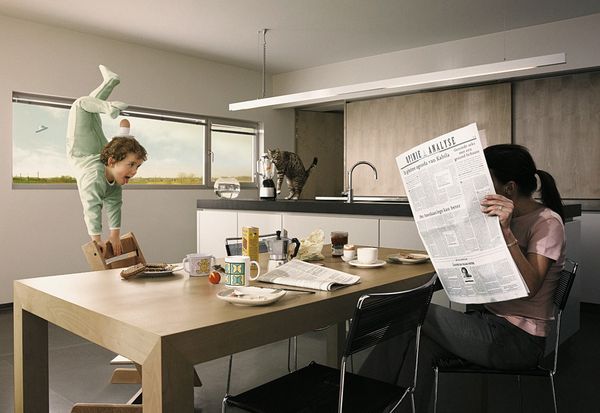Check out Commercial and Industrial Photography section of our forum.
Has the art of Photography changed?
Jun 16, 2013 10:15:14 #
I think the answer to your question is 50% in camera and 50% PP. All digital images are processed ether by the camera itself or in the PP software. J-pegs are processed by the software written into the camera software by the manufacturer. Raw images need to be PP by software. When you change a setting on your camera, you are in effect manipulating the out come of the image. If you change from cloudy mode to sunny you are manipulating the outcome. National Geographic photo contest allow some changes including dodge and burning. If your camera brand you use, does a better job of processing the colors of the photo you enter you will have an edge over someone who doesn't take this into consideration. I like where the photography world is going and the PP world as well. Camera's are changing almost as quick. You can use a camera that takes images that can later change the focus points. Some cameras can take multiple exposures in HDR mode witch produce images that more closely reproduce what the human eye sees in F-stops. The new Canon 1DC takes video 4K that rivals most still images. Before long everyone will just take video and grab a frame for a print. If you want to have a contest without PP images just make the contestants supply the Raw negative so the metadata can be checked. There is room in the world of photography for all levels but a good image or print is still a winner no matter how it got there.
Jun 16, 2013 10:39:20 #
scd wrote:
Having worked as a darkroom technician for photogr... (show quote)
I can obtain the result I want straight out of the camera.
Perhaps my expectations need to be higher.
About 75% of the time though,I adjust light levels. Occasionally I mess with the colour channels, especially when there is a lot of trees or other green vegetation in the image.
If I had Photoshop and had a clue on how to use it I would use it often enough.
You only need to look in the newspaper or magazines to know the importance of large scale manipulation. (especially in advertising)
By Belgian 'Tog' Koen Demuynck

Jun 16, 2013 11:07:31 #
The photographic art is, probably, the same. The acceptance of whatever came out of the digital camera is where the line gets fuzzy. People are willing to accept an email size cell phone snapshot as art. Some photography majors I know is college are beginning to lean that way too. Film takes too long to be able to instantly share a "wonderful" cell phone photo. I've also been told that film takes too much work, probably know how, too. These same people are also the ones that will comment, "Wow, how did you do that" when they look at a 12"x18" inch print I show them.
Check out The Pampered Pets Corner section of our forum.
Jun 16, 2013 11:23:55 #
David Popham
Loc: French Creek, British Columbia
rapier 1931 wrote:
Perhaps now we need two descriptions for what we aspire to be. 1.Photographer who just takes the shot and perhaps does a bit of cropping.2.Photographic artist who makes numerous changes with photo shop etc.
About two years ago my wife and I retired and moved out of the city to a rural environment. I joined the local photography club which at that time had two categories, namely colour and black & white. I just happen to like doing extensive post-processing and submitted a photo. It was rejected and was even to be shown, and I was given a scolding. A month later the exec introduced a new category and labeled it "open". Change happens. New technologies allow different modes of expression, else we would be still spitting dust on the walls of caves.
Jun 16, 2013 12:12:15 #
Crwiwy wrote:
In my days of film cameras - unless you did your o... (show quote)
In my opinion all images need sharpening at the very least. I also think that the only images that should not be tampered with are images that may be used in court, or to document the truth.
Just because images are easier to adjust today in software verses a dark room, doesn't mean that it's not an image or that it's not art. Ansel Adams used a dark room extensively to dodge, burn, clone and remove unwanted matter from his images. Just because he had to smell chemicals and work in the dark doesn't make his works of art any better than digital imagery - it just makes it harder.
Learning to post process images via software isn't any easy task. I've been learning this for years now and I'm nowhere near an expert. My point is that it took years for Ansel Adams to perfect his dark room processing and it also took years for him to learn to use those filters etc. that you spoke of. He probably started out by making many mistakes but after learning how to use his equipment he no longer guessed how to do it, he knew how to use it. Today it's the same. Again I'm no expert on using such things as filters or lighting etc, and I'm no expert in using software. But there are people that are very skilled at this and aren't just learning it, they are doing it. I don't know anyone that just picks up a digital camera, a computer and Photoshop and can use it like an expert right away. It takes knowledge and skill - even to use today's digital equipment.
Jun 16, 2013 12:57:06 #
Michelangelo did use his chisel to remove all the rock that he didn't envision as part of his statue--then, having done that, he polished (some parts more than others), again to make his creation look to your eye as it appeared in his mind. When I studied with Ansel he said "The image your camera captures is only the starting point for creating the image that is in your mind"--but what did they know about art? And, the image your camera captures certainly is only an approximate representation of what actually was--for that matter, the same can be said of your eye--the world looks much different to a bee's vision.
Stan
Stan
Jun 16, 2013 13:10:48 #
Crwiwy wrote:
...are competitions now more about post processing than the actual photo?'.
Take that idea to its extreme and it would all be about creating images from scratch, using generic library images and using graphics suites rather than photo suites. At that point the camera becomes obsolete.
Check out Smartphone Photography section of our forum.
Jun 16, 2013 13:17:58 #
Jun 16, 2013 13:34:32 #
stan0301 wrote:
Michelangelo did use his chisel to remove all the ... (show quote)
"The negative is the score. The print is the performance". -- Ansel Adams
Jun 16, 2013 13:54:08 #
wingclui44
Loc: CT USA
Crwiwy wrote:
In my days of film cameras - unless you did your o... (show quote)
All depends on how they set up the rule on different categories, some allows you to do heavily editing, some are not. I think National Geographic Magazine requires right out of camera images without any editing.
Jun 16, 2013 15:48:16 #
First one must define what is "straight out of the camera" Since one cannot view a "raw" file one must output a jpg. I do know that Nikon allows adjustment to the various aspects of each JPG "treatment" ie Vivid , Landscape, portrait and in each case all variables can be adjusted. Soooo using accepted SOOC, I can really make the colors pop with jagged sharpening and mega contrast. I can also do in camera HDR. Post processing (adjusting the information from the sensor) is a vital part of the digital medium. IMHO
Jun 16, 2013 15:56:39 #
David Popham wrote:
else we would be still spitting dust on the walls of caves.
else we would be still spitting dust on the walls of caves.
Hmmm, always wondered how they did that?!?!
Jun 16, 2013 16:08:14 #
rmalarz wrote:
"The negative is the score. The print is the performance". -- Ansel Adams
This is a good quote. I read a statement from a record label producing classical music a while ago, which said as far as remember; "we never use (post) processing to create a performance, but we will use it to change minor problems in a great performance".
That seems to me be to be a fair shot at what should happen in a competition.
Jun 16, 2013 16:28:35 #
Crwiwy wrote:
In my days of film cameras - unless you did your o... (show quote)
This has been covered here 100 times from 100 different angles. A competitive photo is from the artistic mind of the photographer. If he or she can use the camera to get what he or she wants, then fine. If he or she adds post editing to reach the goal, that's fine too. Just because photography was lacking technology "back in the day" doesn't mean we shouldn't, by some imaginary Bible Of Photographic Sin, not use available technology today. Using it is called advancement and allowing technology to help us grow in our chosen art.
But I do think there should be competition categories of something like "Direct From Camera" and "Post Processed" so it's fair for everyone. Then direct film shots and direct digital shots are competing in the simpler. But then film darkroom tricks could give an advantage over the direct digital shots. Or the in-camera JPG processing could give the direct digital shots an advantage over the direct film shots. That wouldn't be fair either.
Jun 16, 2013 16:33:30 #
marcomarks wrote:
This has been covered here 100 times from 100 diff... (show quote)
that would be up to the folks running the competition. As I mentioned before, An output titled "Straight out of the camera" also has the ability to maximize certain aspects of the final result, Saturation,clarity, contrast,sharpening etc by adjusting within the camera.
If you want to reply, then register here. Registration is free and your account is created instantly, so you can post right away.
Check out The Pampered Pets Corner section of our forum.








